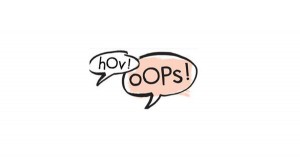Danish Oops! moments Posted by Bjørn A. Bojesen on Jul 31, 2013 in Uncategorized
This month, several of my fellow bloggers here at Transparent Language have been writing about funny mistakes they’ve made while trying to communicate in a foreign language. As a native speaker of Danish, I’m afraid the bits I could share with you wouldn’t be very “juicy” – the few mistakes I can recall are all due to me having lived an “awfully” long time among our Norwegian brothers and sisters! 😉 (Like saying Har alle fået sine billetter? instead of the correct Har alle fået deres billeter? when asking if everybody “have got their tickets?”)
So, I’d rather share with you a few potential pitfalls, small details that you should keep in mind when exploring the flat Danish landscapes and chatting with the hyggelig people.
Getting the vowels right
Danish has more vowels than any other European language, and it’s therefore a good idea to spend some time making sure you don’t pronounce by (city) as bi (bee) or mene ([to] mean) as mine (mine). There’s a joke about prins Henrik, the Danish Queen‘s French-born husband, who likes to go hunting. Once, having returned from a hunting trip, he was supposedly interviewed by a reporter. “Henrik” wanted to say: Vi skød en ræv (We shot a fox). However, according to the joke, what he actually said was: Vi sked en røv (We sh*t an *rse)…
Be aware of the stød
The stød (thrust) is a kind of small hiccup that is largely responsible for making Danish sound … Danish. Normally, you can get along very well without it (but everyone will immediately notice you’re a foreigner! 🙂 ). In a few words, though, it does make a difference.
Bønner (without stød) means “prayers” or “beans”, while bønder (pronounced in the same way, but with stød) means … “farmers”. And if you want to talk about your mor (mother), make absolutely sure you don’t throw in a stød! That would make it sound like mord (murder).
Turning numbers in your head
Danish numbers are confusing until you get used to the system. In most languages, when you see a two-digit number like 21, you say it in the order it’s written: twenty-one. But Danes like to turn things around, and say: “one-and-twenty”: enogtyve. So, take care when sharing your telephone number! When reading aloud, say, 86867272, you have to think “6-and-80, 6-and-80, 2-and-70, 2-and-70”.
Have you ever made an embarrassing mistake while speaking Danish? Please share in the comments section. Danish is a difficult language, so there’s nothing to be ashamed of! 🙂

Build vocabulary, practice pronunciation, and more with Transparent Language Online. Available anytime, anywhere, on any device.
About the Author: Bjørn A. Bojesen
I was born in Denmark, but spent large parts of my childhood and study years in Norway. I later returned to Denmark, where I finished my MA in Scandinavian Studies. Having relatives in Sweden as well, I feel very Scandinavian! I enjoy reading and travelling, and sharing stories with you! You’re always welcome to share your thoughts with me and the other readers.





Comments:
Mianna:
My husband’s cousin was sharing a piece of good news with me and I said, “Jeg er så glad for dig!” I thought I was saying “I am so happy for you!” but I guess it actually meant I was attracted to him. -Yeah. Awkward. lol.
Bjørn A. Bojesen:
@Mianna @Mianna lol 🙂